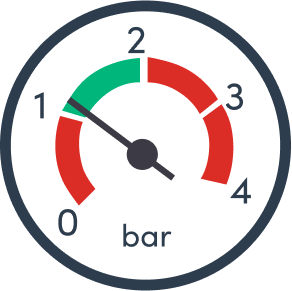1. Boiler is making unusual noises
Worcester Bosch Technical Fault Codes: 1017W, 227V
When you turn on your Worcester Bosch boiler and while it's running, pay attention to the sounds it makes. It's normal to hear a quiet hum, but if the noise is too loud, it could indicate technical problems. These are some of the noises you might identify as being unusual:
Boiler bangs when switched on
Boiler making rattling noises
Boiler makes kettle-like boiling noises
The boiler will try to ignite when you turn it on. However, this does not always happen on the first try, and it may take a couple of attempts to fire. If this happens, there will be excess gas left from the previous unsuccessful attempts. The bursting sound you hear is a result of the burner igniting a large volume of gas.
Technical advice: replace the ignition burner
Ignition burner wears out and breaks over time and is responsible for the inconsistent flaming. Replacing it will result in less gas use and reduce the number of attempts required to successfully fire the burner. Contact Worcester Bosch technical support for more information.
Over time, central heating pumps accumulate air, which leads to airlock. Trapped air causes rattling noises.
Technical advice: remove airlock from the central heating pump
To do so, look behind the boiler casing for the pump. Use a bleed screw to let the air out. Once the air stops hissing and some water flows out of the bleed screw, the airlock should be gone.
You can also try giving the pump a gentle tap, which might free it up enough to stop the noise. This is not a long-term solution, but will give you some time to replace the pump. For pump replacement contact Worcester Bosch technical support.
If your Worcester Bosch boiler has started sounding like your kettle, it's most likely due to internal limescale and sludge accumulation. The build-up of debris and limescale inside the boiler causes some elements of the boiler to clog. While all boilers are prone to sludge build-up, if you reside in an area with hard water, you're more likely to encounter this problem. The hard water areas in the UK are listed here.
Technical advice: practice preventive measures
It can be extremely difficult and expensive to remove limescale, once it has built up. If the parts can be replaced or cleaned, we recommend installing a scale reducer to prevent this problem in the future. Scale reducers protect heating systems against damages caused by hard water and limescale. They do this by affecting the molecular structure of the scale. Scale reducers cost, on average, £30-£40 and are widely available online.
2. Boiler Pressure is too low or too high

As Worcester Bosch central heating systems are sealed, they need to be pressurised to effectively move the water around your house. Boiler pressure is crucial to the smooth operation of your heating system. Therefore, it is important to check the pressure regularly. Usually, once every couple of months is sufficient. However, keep in mind that over time, boilers tend to lose pressure and may require more frequent inspection.
To check your Worcester Bosch boiler’s pressure, look at the pressure gauge that is located on the front of your boiler or under the control panel. Take values between 1 and 1.5 as a norm (when the heating system is cool). When heated, the pressure is likely to rise to 2.5, and this is fine. However, if the needle lands outside of this range, there is likely a problem.
High pressure
Low pressure
Worcester Bosch Technical Fault Codes: E9, A1, 224V, 1065B, 20970B
High pressure most likely means there is too much water in the system. If the pressure is too high, it may lead to leaks in the pipework or the boiler.
Technical advice: bleed your radiators
A common fix would be to bleed your radiators to remove excess pressure.
Worcester Bosch Technical Fault Codes: 2970B, 2971B, 1017W
A low or constantly falling pressure often leads to boiler lockout, meaning the boiler will switch itself off. Fail-safe mechanisms inside your boiler will activate and lock the boiler to prevent harmful scenarios until the issue is resolved.
Technical advice: check for leaking and pressurise the boiler
Almost always pressure loss is caused by a leak. If low boiling pressure only occurs when your heating is switched on, there may be a tiny leak somewhere in the system. It is likely a small component located inside the system. However, if the boiler loses pressure even when the system is switched off, there is likely a larger, more obvious leak you can probably locate yourself. Check for leaks around towel rails, pipework and radiators.
Next, you will need to repressurise the boiler. How you do this will depend on the type of filling loop you have. A detailed guide for repressurising Worcester Bosch boilers through different filling loops can be found here.
The pressure in the system will usually require topping up once or twice a year. If you are having to repressurise your heating system more often, please contact Worcester Bosch technical support.
Avoid unexpected costs.
With a Smart Plan cover policy, you can rest easy knowing if there's an issue with your boiler, we'll usually have you back up and running within 48 hours.
3. Boiler leaking
Worcester Bosch Technical Fault Codes: EA338, A281
Leaking usually occurs through small holes in the pipework or broken seals. It may be one of the consequences of high pressure. Sometimes, leaking may signal a more serious issue, like corrosion to internal components.
Technical advice: consider replacing the boiler
While small holes can be fixed easily, if the leaking is caused by corrosion of key components, for example heat exchangers, expect to pay a significant amount for repair, typically anywhere between £400-£500. So if you own an old boiler that is no longer covered by a warranty it may make more financial sense to get a replacement boiler.
4. Frozen condensate pipes
Worcester Bosch Technical Fault Code: D5
The condensate pipe is essential to your heating system, as it removes the acidic water created during the heating process. It is very thin and in most households it is placed outside and flows into the drain. During winter months, the water in your pipe can freeze, which will cause the condensate to back up into the boiler, causing the system to fail.
Technical advice: place something hot on top of the pipe
The solution is very basic: pour some hot water over the pipe or place a hot cloth on top of it. Then make sure to restart the boiler to get the system running. Although this issue is easily fixed, If you face this issue often during winter months, consider lagging or insulating the pipe. During insulation, fibreglass or plastic wrap is used to keep your pipes warm, prevent them from freezing in frigid temperatures and reduce heat-loss.
5. No heating, no water or both
Worcester Bosch Technical Fault Code: N/A
If there is no heat in the system at all, this could signal a breakage in one of the key parts (valve, diaphragm or airlock). A common issue is the valves being stuck in a certain position.
Most Worcester Bosch boilers have a motorised control valve (also known as a Y-plan or mid-position valve). This valve is responsible for controlling the flow of heated water. Like any other part, control valves can wear out and when they do, they get stuck. When this happens, hot water may not reach a part of the system.
If you have a combination boiler and either your heating or water is hot, another part is faulty. A diverter valve is a mechanism in a combination boiler that opens or closes to direct hot water either to radiators or taps and showers. It would first filter water to get to the taps, and when they’re off, water will be used towards heating.
Technical advice: call an engineer
There is nothing you can do to repair or replace the valves yourself, so the best idea is to contact an engineer or directly to the Worcester Bosch technical support line.
Let us fix your boiler.
At Smart Plan we have thousands of engineers up and down the country who are ready to fix your issue. We guarantee an engineer to your property within 48 hours.
6. Radiators are cold
Worcester Bosch Technical Fault Code: A1281
If your radiators are cold at the top, while remaining warm at the bottom, this can signal an issue with the pump. This is a central component that directs hot water to all parts of the system, including radiators. It might also run while large pockets of air are trapped in the heating system.
If your radiators are hot at the top, but cold at the bottom, this might indicate clogging with heating sludge. Sludge can be removed by a professional.
Technical advice:
Bleed the radiators
Arrange a hot flush
Identify the radiators that feel cool and bleed them. Chances are, you’ve done this before. If not, or you need some technical instructions, read our step-by-step guide on bleeding your radiators here.
To remove heating sludge and get radiators inspected, contact Worcester Bosch technical helpline.You can run chemicals through the system to get rid of the debris. This can either be done under normal pressure (Hot flush) or under pressure (Power flush) for more significant blockages. To prevent further build up, consider purchasing a boiler sludge filter.
7. Pilot light going out
Worcester Bosch Technical Fault Code: EA227
A pilot light is a small flame that serves as ignition within the combustion chamber. Issues with the pilot light are most likely related to gas supply, which makes it a high priority and potentially dangerous problem. The thermocouple sensor might be faulty and the gas will continue to flow even after the pilot light has been extinguished. This requires immediate repair.
Other problems may include carbon build-up on the pilot light or pilot light being blown out by windy conditions.
Technical advice: call a Gas Safe engineer
Whatever the cause, call a Gas Safe engineer as soon as you observe this issue and if it persists. Contact Worcester Bosch Technical helpline for more information.
8. Thermostat is not responding
Worcester Bosch Technical Fault Code: A21
Thermostats allow you to regulate the temperature of your heating system by controlling the boiler based on the settings you enter. However, thermostats can fail to function properly, resulting in uncomfortable house temperatures.
Technical advice: check your thermostat settings
Start with checking your thermostat settings: the temperature might be set below the threshold which stops the system from heating up. Try setting the target temperature at least 2 degrees above or below current temperature. Refer to your Worcester Bosch technical manual to find out how to do this on your thermostat. Also ensure that the control has enough battery and is connected to the boiler. Check our detailed Worcester Bosch technical thermostat troubleshooting here.


